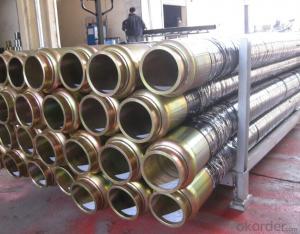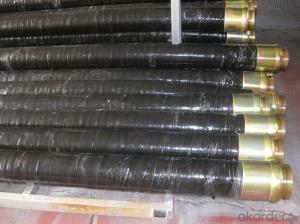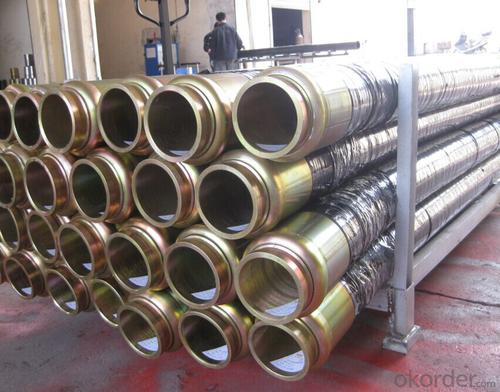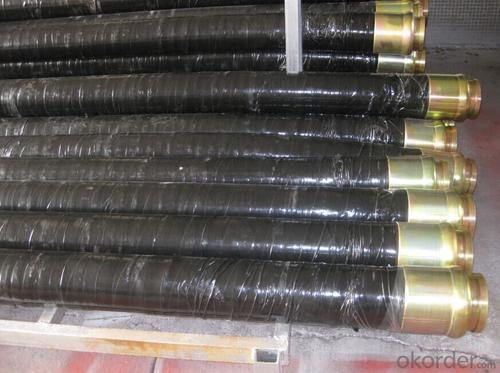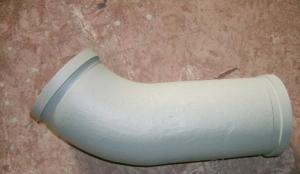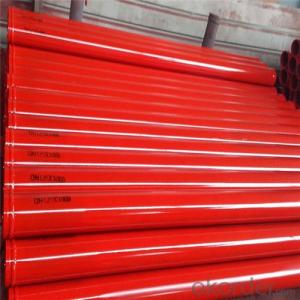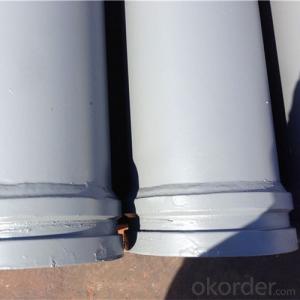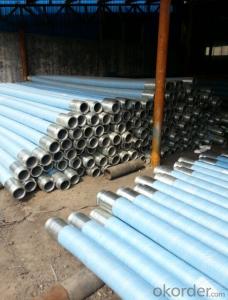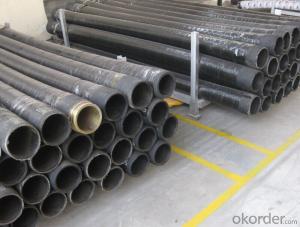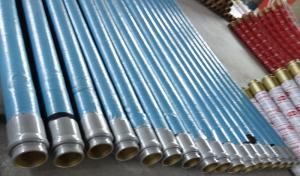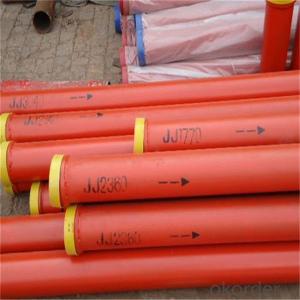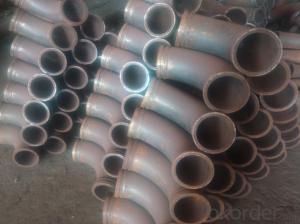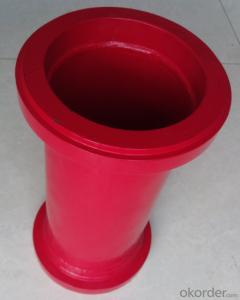6M*DN150 RUBBER END HOSE WITH ONE SIDE COUPLINGS WORKING PRESSURE 85 BAR
- Loading Port:
- Shanghai
- Payment Terms:
- TT OR LC
- Min Order Qty:
- 10 pc
- Supply Capability:
- 5000 pc/month
OKorder Service Pledge
OKorder Financial Service
You Might Also Like
Specifications
Putzmeister concrete pump end rubber hose
1. Size: DN150, DN125, DN100, DN80...
2. Length: 1~9m
Concrete pump end rubber hose PM &Schwing
Name | Specifications | Application | Flange diameter | Remarks |
Rubber hose | DN125*3000 | Concrete pump | 148/DN157mm | |
Rubber hose | DN150*3000 | Concrete pump | 148/DN157mm | |
High pressure | DN125*3000 | Concrete pump | 148/DN157mm | Two layers of steel wire |
High pressure | DN125*3000 | Concrete pump | 148/DN157mm | Four layers of steel wire |
High pressure | DN125*4000 | Concrete pump | 148/DN157mm | |
High pressure | DN150*3000 | Concrete pump | 175mm | |
| DN80*5000 | Mortar pump mini conctete pump | 98mm | |
| DN80*6000 | Mortar pump mini conctete pump | 98mm | |
| DN100*5000 | Mortar pump mini conctete pump | 124mm | |
| DN76*6000 | Fine stone concrete pump mini conctete pump |
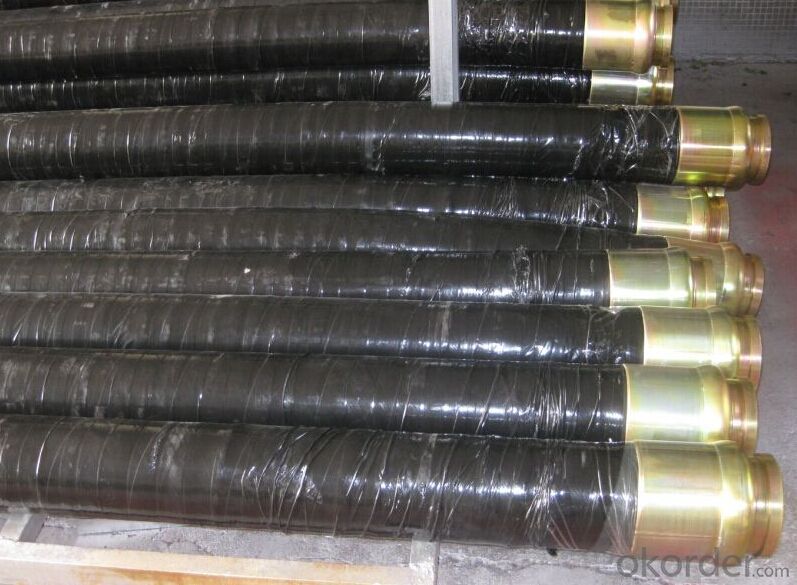
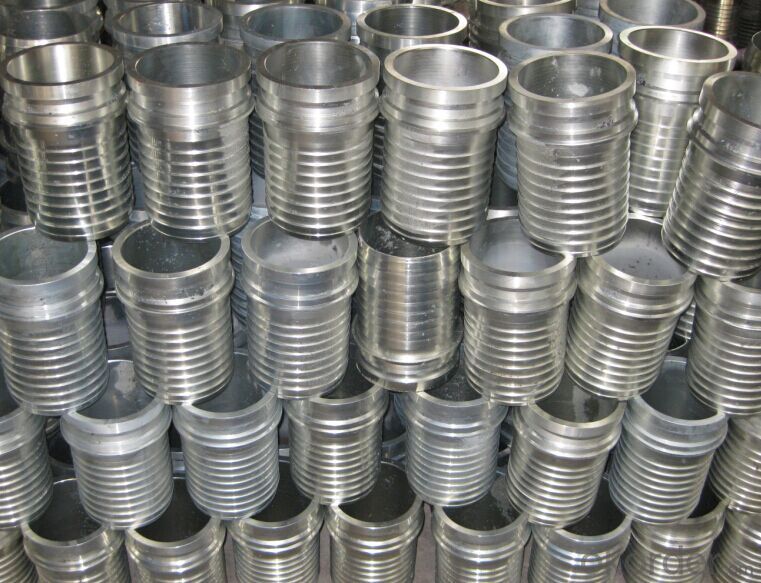
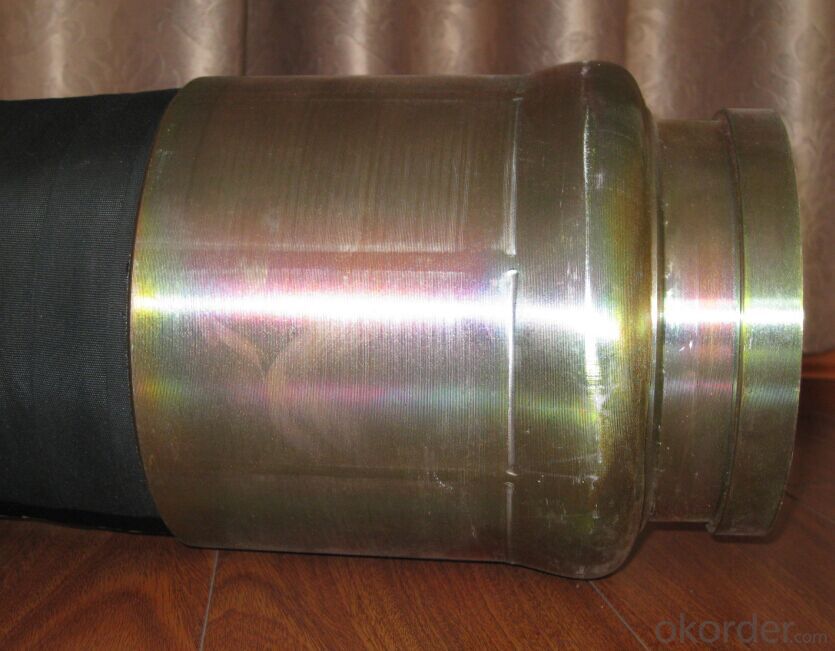
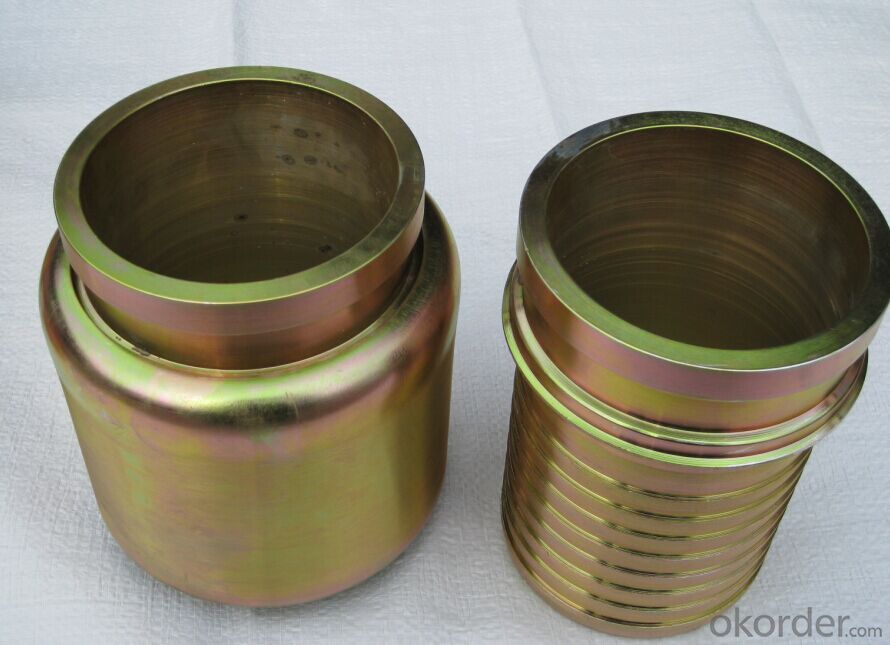
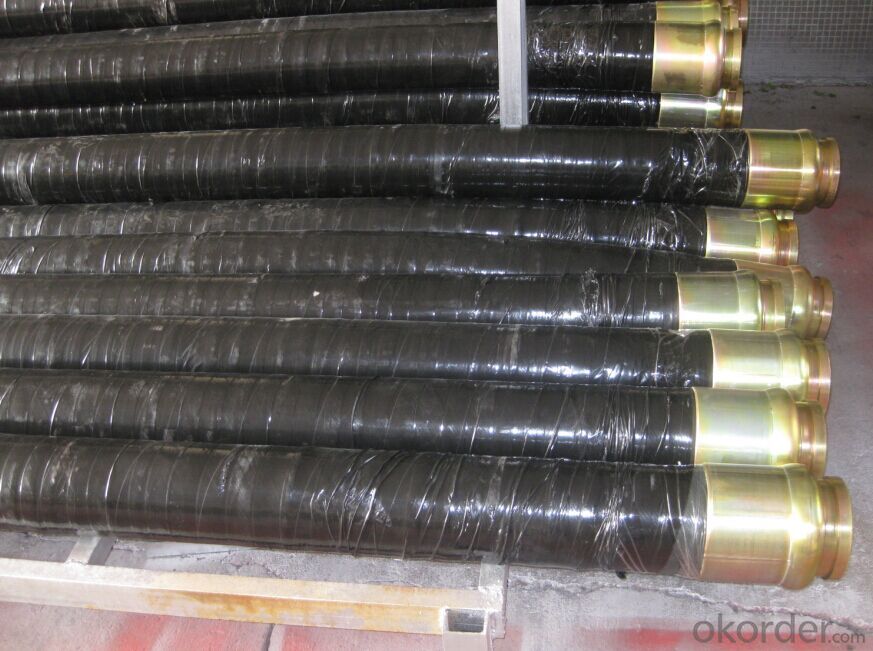
- Q: Are there any specific guidelines for the selection and installation of hydraulic components in concrete pump spare parts?
- Yes, there are specific guidelines for the selection and installation of hydraulic components in concrete pump spare parts. When choosing hydraulic components for concrete pump spare parts, it is important to consider factors such as the maximum operating pressure, flow rate, and compatibility with the existing hydraulic system. Firstly, it is crucial to ensure that the selected hydraulic components can handle the maximum operating pressure of the concrete pump. This includes components such as hydraulic cylinders, valves, and pumps. Choosing components with a higher pressure rating than the concrete pump's operating pressure can help ensure their durability and longevity. Secondly, the flow rate of the hydraulic components should match the requirements of the concrete pump system. Components such as hydraulic pumps and valves must be able to provide sufficient flow to operate the concrete pump effectively. It is important to consider factors such as the size of the concrete pump, the desired output capacity, and the specific pumping requirements. Moreover, compatibility with the existing hydraulic system is crucial for the smooth operation of the concrete pump. Hydraulic components should be selected based on their compatibility with the existing system in terms of fittings, connections, and overall design. It is advisable to consult the manufacturer's guidelines or seek professional advice when selecting and installing hydraulic components in concrete pump spare parts. Furthermore, proper installation is essential to ensure the optimal performance and safety of hydraulic components in concrete pump spare parts. It is recommended to follow the manufacturer's installation instructions and guidelines. The installation process should include proper alignment, secure mounting, and appropriate sealing of the components to prevent any leaks or failures. In conclusion, there are specific guidelines for the selection and installation of hydraulic components in concrete pump spare parts. Considering factors such as maximum operating pressure, flow rate, compatibility, and following proper installation procedures can help ensure the efficient and safe operation of the concrete pump system.
- Q: What are the most commonly replaced spare parts for concrete pumps?
- The most commonly replaced spare parts for concrete pumps typically include wear plates, wear rings, and delivery cylinders. These components are subject to constant abrasion and wear due to the nature of their operation, which involves the movement of concrete at high pressures and velocities. Wear plates are usually made of hardened steel and are installed in the hopper and other high-wear areas to protect against the abrasive action of concrete. Wear rings, which are typically made of polyurethane or other durable materials, are used to reduce friction between the piston and cylinder, minimizing wear and maintaining optimal performance. Delivery cylinders, also known as pumping cylinders, are responsible for transferring the concrete from the hopper to the discharge outlet. Over time, the interior surface of the cylinder can become worn or damaged, necessitating replacement to ensure efficient concrete flow. Other commonly replaced spare parts for concrete pumps may include pistons, seals, hydraulic hoses, and couplings, as they are also subject to wear and tear during the pumping process. Regular inspection and maintenance of these components are essential to prevent unexpected equipment downtime and to ensure the long-term reliability and performance of concrete pumps.
- Q: How often should concrete pump hydraulic oil coolers be inspected and maintained?
- Concrete pump hydraulic oil coolers should be inspected and maintained regularly, ideally on a monthly basis or as recommended by the manufacturer. Regular inspections and maintenance ensure optimal performance and help identify any potential issues or damage that may affect the efficiency and lifespan of the equipment.
- Q: What are the signs of a damaged concrete pump cylinder?
- Some signs of a damaged concrete pump cylinder can include reduced pumping performance, loss of pressure, leaks or drips around the cylinder, abnormal noises during operation, uneven wear or scoring on the cylinder wall, and visible cracks or deformations on the cylinder body.
- Q: What are the different types of concrete pump hopper cylinders?
- There are several different types of concrete pump hopper cylinders that are commonly used in the construction industry. These cylinders play a crucial role in the operation of concrete pumps by providing the necessary pressure and force to move the concrete through the system. One type of concrete pump hopper cylinder is the single-acting cylinder. This type of cylinder operates by using hydraulic pressure to extend the piston rod, which in turn pushes the concrete out of the hopper and into the pumping system. Single-acting cylinders are known for their simplicity and reliability, making them a popular choice for many construction projects. Another type of concrete pump hopper cylinder is the double-acting cylinder. As the name suggests, this type of cylinder operates in both directions, allowing for a more efficient and powerful pumping process. Double-acting cylinders are capable of pushing the concrete out of the hopper during the extension stroke and pulling the piston rod back during the retraction stroke, resulting in a higher pumping capacity and increased productivity. Additionally, there are also different sizes and capacities of concrete pump hopper cylinders available, ranging from smaller cylinders suitable for smaller construction projects to larger cylinders capable of handling heavy-duty pumping operations. The choice of cylinder size depends on factors such as the volume of concrete to be pumped, the distance and height of the pumping location, and the specific requirements of the project. In conclusion, the different types of concrete pump hopper cylinders include single-acting cylinders and double-acting cylinders. Each type has its own advantages and is suitable for different construction applications. The size and capacity of the cylinder should be chosen based on the specific needs of the project. Ultimately, selecting the right type of cylinder is crucial for ensuring efficient and effective concrete pumping operations.
- Q: How often should concrete pump booms be inspected and maintained?
- To ensure the safe and efficient operation of concrete pump booms, it is important to inspect and maintain them regularly. The frequency of these inspections and maintenance tasks will depend on how often and under what conditions the boom is used. Generally, it is recommended to inspect and maintain the boom at least once a month or after every 250 pumping hours, whichever comes first. During these inspections, it is crucial to carefully examine the boom for any signs of wear and tear, damage, or malfunctioning parts. The hydraulic system, including the hoses, cylinders, and valves, should be thoroughly inspected and tested for leaks, blockages, or malfunctions. Additionally, the structural integrity of the boom, such as the main boom, articulation points, and outriggers, should be checked for cracks, deformations, or signs of stress. Regular maintenance of the concrete pump boom should include cleaning and lubricating all movable parts, checking and adjusting the tension of the cables, belts, and chains, and replacing any worn-out or damaged components. It is also important to inspect and test the electrical and control systems to ensure proper functioning. In addition to regular inspections and maintenance, it is crucial to follow the manufacturer's guidelines and recommendations for specific maintenance intervals and procedures. Depending on the level of usage, working conditions, and any changes in performance or operation, it may be necessary to conduct more frequent inspections and maintenance. By conducting regular inspections and maintenance, concrete pump boom owners can reduce the risk of accidents, extend the lifespan of the equipment, and ensure optimal performance. It is always advisable to consult with the manufacturer or a qualified professional to determine the most suitable inspection and maintenance schedule for a specific concrete pump boom.
- Q: What is the function of a concrete pump remote control?
- The function of a concrete pump remote control is to allow operators to control the movement and operation of a concrete pump from a distance. This remote control enables precise and efficient placement of concrete, allowing the operator to adjust the pump's speed, direction, and other functions, ensuring the accurate and controlled delivery of concrete to the desired location.
- Q: When concrete is poured, how high can the concrete pump be put?
- When the floor height exceeds the applicable height of the automobile pump, the ground pump (stationary pump) is used to pour and grind the concrete, and the height of the pump can reach more than 100 meters to two hundred meters
- Q: Can I get spare parts for concrete pump wear plates and cutting rings?
- Yes, you can definitely get spare parts for concrete pump wear plates and cutting rings. These parts are essential for the smooth operation and performance of a concrete pump. Many manufacturers and suppliers specialize in providing spare parts for concrete pumps, including wear plates and cutting rings. You can contact these suppliers or manufacturers directly to inquire about the availability and pricing of these spare parts. Additionally, there are also online platforms and marketplaces where you can find a wide range of spare parts for various concrete pump models. It is always recommended to ensure that you purchase genuine and high-quality spare parts to guarantee the longevity and efficiency of your concrete pump.
- Q: What are the signs of a damaged or malfunctioning electric motor?
- A damaged or malfunctioning electric motor can be identified by several signs. Firstly, unusual noises like grinding, squealing, or banging sounds are typically indicative of a problem. Such sounds may suggest that the motor's bearings are worn out or that there is an issue with its internal components. Secondly, excessive heat is another sign of a damaged electric motor. If the motor feels hotter than usual to the touch, it could indicate that the motor is working harder than it should or that there is an issue with its cooling system. Thirdly, a motor that frequently trips the circuit breaker or blows fuses clearly indicates a malfunction. This could be caused by an electrical fault within the motor or an overload due to a faulty component. Furthermore, a damaged electric motor may exhibit reduced performance or a noticeable decrease in power output. This can be observed as a decrease in speed or torque produced by the motor, or even a complete inability to start or function properly. Lastly, excessive vibration or shaking of the motor may indicate misalignment or a problem with its mounting. If not addressed promptly, this can lead to further damage. If any of these signs are noticed, it is recommended to immediately cease using the motor and seek the assistance of a qualified technician or electrician to diagnose and repair the issue. Ignoring or continuing to use a damaged motor can result in further damage and potentially dangerous situations.
Send your message to us
6M*DN150 RUBBER END HOSE WITH ONE SIDE COUPLINGS WORKING PRESSURE 85 BAR
- Loading Port:
- Shanghai
- Payment Terms:
- TT OR LC
- Min Order Qty:
- 10 pc
- Supply Capability:
- 5000 pc/month
OKorder Service Pledge
OKorder Financial Service
Similar products
Hot products
Hot Searches
Related keywords
